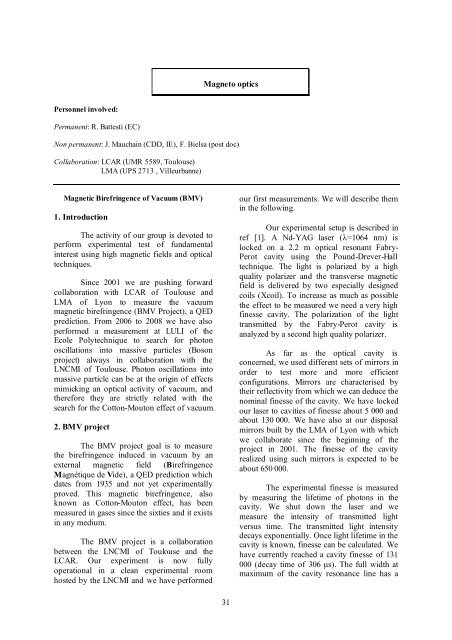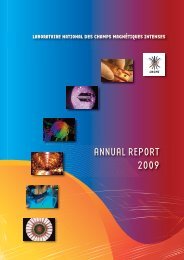Laboratoire National des Champs Magnétiques Pulsés CNRS – INSA
Laboratoire National des Champs Magnétiques Pulsés CNRS – INSA
Laboratoire National des Champs Magnétiques Pulsés CNRS – INSA
You also want an ePaper? Increase the reach of your titles
YUMPU automatically turns print PDFs into web optimized ePapers that Google loves.
Personnel involved:<br />
Permanent: R. Battesti (EC)<br />
Magneto optics<br />
Non permanent: J. Mauchain (CDD, IE), F. Bielsa (post doc)<br />
Collaboration: LCAR (UMR 5589, Toulouse)<br />
LMA (UPS 2713 , Villeurbanne)<br />
Magnetic Birefringence of Vacuum (BMV)<br />
1. Introduction<br />
The activity of our group is devoted to<br />
perform experimental test of fundamental<br />
interest using high magnetic fields and optical<br />
techniques.<br />
Since 2001 we are pushing forward<br />
collaboration with LCAR of Toulouse and<br />
LMA of Lyon to measure the vacuum<br />
magnetic birefringence (BMV Project), a QED<br />
prediction. From 2006 to 2008 we have also<br />
performed a measurement at LULI of the<br />
Ecole Polytechnique to search for photon<br />
oscillations into massive particles (Boson<br />
project) always in collaboration with the<br />
LNCMI of Toulouse. Photon oscillations into<br />
massive particle can be at the origin of effects<br />
mimicking an optical activity of vacuum, and<br />
therefore they are strictly related with the<br />
search for the Cotton-Mouton effect of vacuum.<br />
2. BMV project<br />
The BMV project goal is to measure<br />
the birefringence induced in vacuum by an<br />
external magnetic field (Birefringence<br />
Magnétique de Vide), a QED prediction which<br />
dates from 1935 and not yet experimentally<br />
proved. This magnetic birefringence, also<br />
known as Cotton-Mouton effect, has been<br />
measured in gases since the sixties and it exists<br />
in any medium.<br />
The BMV project is a collaboration<br />
between the LNCMI of Toulouse and the<br />
LCAR. Our experiment is now fully<br />
operational in a clean experimental room<br />
hosted by the LNCMI and we have performed<br />
31<br />
our first measurements. We will <strong>des</strong>cribe them<br />
in the following.<br />
Our experimental setup is <strong>des</strong>cribed in<br />
ref [1]. A Nd-YAG laser (�=1064 nm) is<br />
locked on a 2.2 m optical resonant Fabry-<br />
Perot cavity using the Pound-Drever-Hall<br />
technique. The light is polarized by a high<br />
quality polarizer and the transverse magnetic<br />
field is delivered by two especially <strong>des</strong>igned<br />
coils (Xcoil). To increase as much as possible<br />
the effect to be measured we need a very high<br />
finesse cavity. The polarization of the light<br />
transmitted by the Fabry-Perot cavity is<br />
analyzed by a second high quality polarizer.<br />
As far as the optical cavity is<br />
concerned, we used different sets of mirrors in<br />
order to test more and more efficient<br />
configurations. Mirrors are characterised by<br />
their reflectivity from which we can deduce the<br />
nominal finesse of the cavity. We have locked<br />
our laser to cavities of finesse about 5 000 and<br />
about 130 000. We have also at our disposal<br />
mirrors built by the LMA of Lyon with which<br />
we collaborate since the beginning of the<br />
project in 2001. The finesse of the cavity<br />
realized using such mirrors is expected to be<br />
about 650 000.<br />
The experimental finesse is measured<br />
by measuring the lifetime of photons in the<br />
cavity. We shut down the laser and we<br />
measure the intensity of transmitted light<br />
versus time. The transmitted light intensity<br />
decays exponentially. Once light lifetime in the<br />
cavity is known, finesse can be calculated. We<br />
have currently reached a cavity finesse of 131<br />
000 (decay time of 306 μs). The full width at<br />
maximum of the cavity resonance line has a







